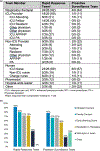How do we detect and respond to clinical deterioration in hospitalized children? Results of the Pediatric Care BefOre Deterioration Events (CODE) survey
- PMID: 37861210
- PMCID: PMC12444532
- DOI: 10.1002/jhm.13224
How do we detect and respond to clinical deterioration in hospitalized children? Results of the Pediatric Care BefOre Deterioration Events (CODE) survey
Abstract
Systems to detect and respond to deteriorating hospitalized children are common despite little evidence supporting best practices. Our objective was to describe systems to detect/respond to deteriorating hospitalized children at Pediatric Resuscitation Quality Collaborative (pediRES-Q) institutions. We performed a cross-sectional survey of pediRES-Q leaders. Questionnaire design utilized expert validation and cognitive interviews. Thirty centers (88%) responded. Most (93%) used ≥1 system to detect deterioration: most commonly, early warning scores (83%), watcher lists (55%), and proactive surveillance teams (31%). Most (90%) had a team to respond to deteriorating patients and the majority of teams could be activated by clinician or family concerns. Most institutions (90%) collect relevant data, including number of rapid responses (88%), arrests outside intensive care units (100%), and serious safety events (88%). In conclusion, most pediRES-Q institutions utilize systems to detect/respond to deteriorating hospitalized children. Heterogeneity exists among programs. Rigorous evaluation is needed to identify best practices.
© 2023 Society of Hospital Medicine.
Conflict of interest statement
CONFLICT OF INTEREST STATEMENT
Dr. Vinay Nadkarni serves as the President of the Society of Critical Care Medicine (SCCM). The views expressed in the manuscript are his and are not intended to represent the views of the SCCM. The remaining authors declare no conflict of interest
Figures
References
-
- Lockwood JM, Ziniel SI, Bonafide CP, et al. Characteristics of pediatric rapid response systems: results from a survey of PRIS hospitals. Hosp Pediatr 2021;11(2):144–152. - PubMed
-
- Chapman SM, Wray J, Oulton K, Peters MJ. Systematic review of paediatric track and trigger systems for hospitalised children. Resuscitation. 2016;109:87–109. - PubMed
-
- Nadkarni V Pediatric Resuscitation Quality Collaborative. pediRES‐Q; 2022. Accessed September 1, 2023. https://www.pedires-q.org/
Publication types
MeSH terms
Grants and funding
- K08 HS026975/HS/AHRQ HHS/United States
- AHRQ K08HS026975/Dr. Maya Dewan was supported by a grant from the Agency for Healthcare Research and Quality
- Dr. Nadkarni is the PI for unrestricted research and educational grants to his institution from Zoll Medical, the Laerdal Foundation, and RQI Partners.
- The Pediatric Resuscitation Quality Collaborative is supported by an unrestricted grant from Zoll
LinkOut - more resources
Full Text Sources
Medical


